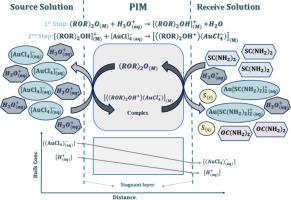当前位置:
X-MOL 学术
›
Hydrometallurgy
›
论文详情
Our official English website, www.x-mol.net, welcomes your
feedback! (Note: you will need to create a separate account there.)
Investigating the mechanism of Au(III) transport using a polymer inclusion membrane with dibutyl carbitol as a carrier
Hydrometallurgy ( IF 4.8 ) Pub Date : 2024-05-26 , DOI: 10.1016/j.hydromet.2024.106339 Meisam Ghiasi , Mahmoud Abdollahy , Mahdi Abdollahi , Mehdi Mohseni
Hydrometallurgy ( IF 4.8 ) Pub Date : 2024-05-26 , DOI: 10.1016/j.hydromet.2024.106339 Meisam Ghiasi , Mahmoud Abdollahy , Mahdi Abdollahi , Mehdi Mohseni

|
In this article, firstly, the separation and transfer of Au(III) from gold chloride solution was investigated using a polymer inclusion membrane (PIM) system containing dibutyl carbitol (DBC) as carrier molecules, dioctyl phthalate (DOP), bis(2-ethyl hexyl) adipate (dioctyl adipate) (DOA) and tris (2-ethyl hexyl) phosphate (T2EHP) as plasticizers and high molecular weight polyvinyl chloride (PVC) as the base polymer. Fourier transform infrared spectroscopy (FT-IR), and scanning electron microscope (SEM) were used to identify PIMs. Kinetic studies featuring a two-step reaction, with the first step being reversible, were conducted across various sections to investigate the processes of extraction, stripping, and transport. The effects of different stripping agents such as water, HCl, thiourea, sodium thiosulfate, and oxalic acid was investigated, and the best results were obtained with thiourea. Also, the mechanisms of Au(III) extraction and transport were studied. Under the conditions of source solution, tetrachloroaurate anionic complex with protonated DBC () was extracted by ion solvation mechanism. The validity of the proposed extraction mechanism was confirmed through the use of nuclear magnetic resonance (H NMR) spectroscopy. In order to make the membrane with the best composition and the highest efficiency, the effect of weight percentage of the carrier and plasticizer was investigated. There was an optimal value for the weight percentage of plasticizer (10–20% by weight) and carrier (40%), in which the highest flux and permeability in the membrane occurred. The effect of the viscosity of different plasticizers (DOP, DOA, and T2EHP) on the Au(III) flux was also investigated. It was found that the flux increases linearly with the reduction of plasticizer viscosity. Effect of membrane thickness on the permeability, initial flux, and efficiency of Au(III) transfer, were conducted with thickness of 120, 80, 45, and 30 μm. By reducing the thickness of the membrane, the transfer flux, permeability and percent of Au(III) transport, were improved from 12.9 × 10, 45.3 × 10 and 18.2% to 26.4 × 10, 83.5 × 10 and 37.3%, respectively. According to the results, a membrane with a combination of PVC:DBC:D2EHP with a weight percentage ratio of 50:40:10 with a thickness of 30 μm was suggested. Optimized results with the proposed membrane were obtained to be: extraction rate constant of 1.43 , extraction percent of 99.1%, stripping rate constant of 37.5 × 10, stripping percent of 40.9%, and permeability of 27.0 × 10, initial flux of 82.1 × 10.
中文翻译:

以二丁基卡必醇为载体的聚合物包合膜研究 Au(III) 的传输机制
本文首先采用以二丁基卡必醇(DBC)为载体分子、邻苯二甲酸二辛酯(DOP)、双(2-己二酸乙基己酯(己二酸二辛酯)(DOA)和磷酸三(2-乙基己基)酯(T2EHP)作为增塑剂,高分子量聚氯乙烯(PVC)作为基础聚合物。傅里叶变换红外光谱(FT-IR)和扫描电子显微镜(SEM)用于鉴定PIM。动力学研究以两步反应为特色,第一步是可逆的,在不同部分进行,以研究提取、汽提和运输过程。研究了不同剥离剂(例如水、HCl、硫脲、硫代硫酸钠和草酸)的效果,并且使用硫脲获得了最佳效果。此外,还研究了 Au(III) 的提取和运输机制。在源溶液条件下,通过离子溶剂化机制萃取出四氯金酸盐阴离子与质子化DBC()的络合物。通过使用核磁共振(1H NMR)光谱证实了所提出的提取机制的有效性。为了使膜具有最佳的组成和最高的效率,考察了载体和增塑剂的重量百分比的影响。增塑剂(10-20%重量)和载体(40%)的重量百分比存在一个最佳值,此时膜的通量和渗透率最高。还研究了不同增塑剂(DOP、DOA 和 T2EHP)的粘度对 Au(III) 助熔剂的影响。结果发现,通量随着增塑剂粘度的降低而线性增加。 使用 120、80、45 和 30 μm 的厚度进行膜厚度对渗透性、初始通量和 Au(III) 转移效率的影响。通过减小膜的厚度,传输通量、渗透率和 Au(III) 传输百分比分别从 12.9 × 10、45.3 × 10 和 18.2% 提高到 26.4 × 10、83.5 × 10 和 37.3%。根据结果,建议采用重量百分比为 50:40:10 的 PVC:DBC:D2EHP 组合、厚度为 30 μm 的膜。所提出的膜的优化结果为:萃取速率常数为1.43,萃取百分比为99.1%,汽提速率常数为37.5×10,汽提百分比为40.9%,渗透率为27.0×10,初始通量为82.1×10 。
更新日期:2024-05-26
中文翻译:

以二丁基卡必醇为载体的聚合物包合膜研究 Au(III) 的传输机制
本文首先采用以二丁基卡必醇(DBC)为载体分子、邻苯二甲酸二辛酯(DOP)、双(2-己二酸乙基己酯(己二酸二辛酯)(DOA)和磷酸三(2-乙基己基)酯(T2EHP)作为增塑剂,高分子量聚氯乙烯(PVC)作为基础聚合物。傅里叶变换红外光谱(FT-IR)和扫描电子显微镜(SEM)用于鉴定PIM。动力学研究以两步反应为特色,第一步是可逆的,在不同部分进行,以研究提取、汽提和运输过程。研究了不同剥离剂(例如水、HCl、硫脲、硫代硫酸钠和草酸)的效果,并且使用硫脲获得了最佳效果。此外,还研究了 Au(III) 的提取和运输机制。在源溶液条件下,通过离子溶剂化机制萃取出四氯金酸盐阴离子与质子化DBC()的络合物。通过使用核磁共振(1H NMR)光谱证实了所提出的提取机制的有效性。为了使膜具有最佳的组成和最高的效率,考察了载体和增塑剂的重量百分比的影响。增塑剂(10-20%重量)和载体(40%)的重量百分比存在一个最佳值,此时膜的通量和渗透率最高。还研究了不同增塑剂(DOP、DOA 和 T2EHP)的粘度对 Au(III) 助熔剂的影响。结果发现,通量随着增塑剂粘度的降低而线性增加。 使用 120、80、45 和 30 μm 的厚度进行膜厚度对渗透性、初始通量和 Au(III) 转移效率的影响。通过减小膜的厚度,传输通量、渗透率和 Au(III) 传输百分比分别从 12.9 × 10、45.3 × 10 和 18.2% 提高到 26.4 × 10、83.5 × 10 和 37.3%。根据结果,建议采用重量百分比为 50:40:10 的 PVC:DBC:D2EHP 组合、厚度为 30 μm 的膜。所提出的膜的优化结果为:萃取速率常数为1.43,萃取百分比为99.1%,汽提速率常数为37.5×10,汽提百分比为40.9%,渗透率为27.0×10,初始通量为82.1×10 。


















































 京公网安备 11010802027423号
京公网安备 11010802027423号